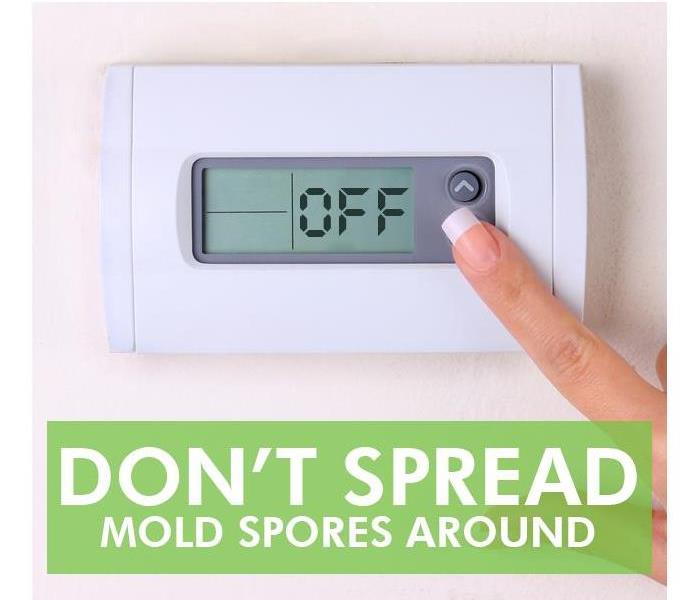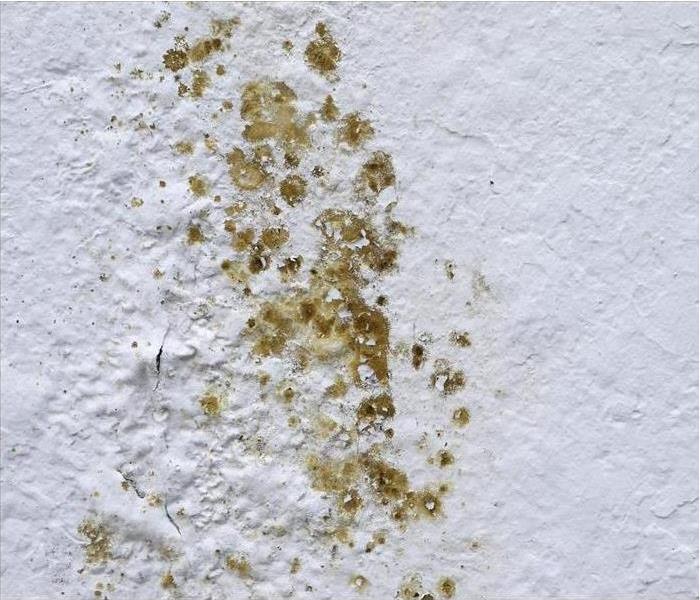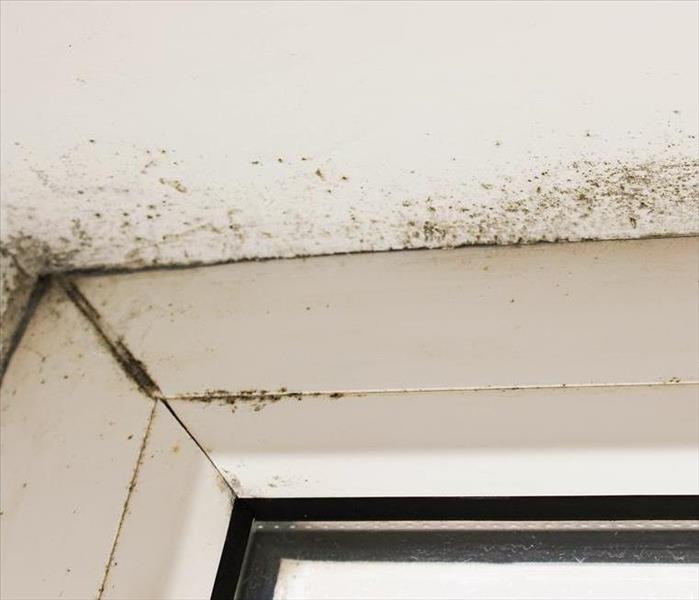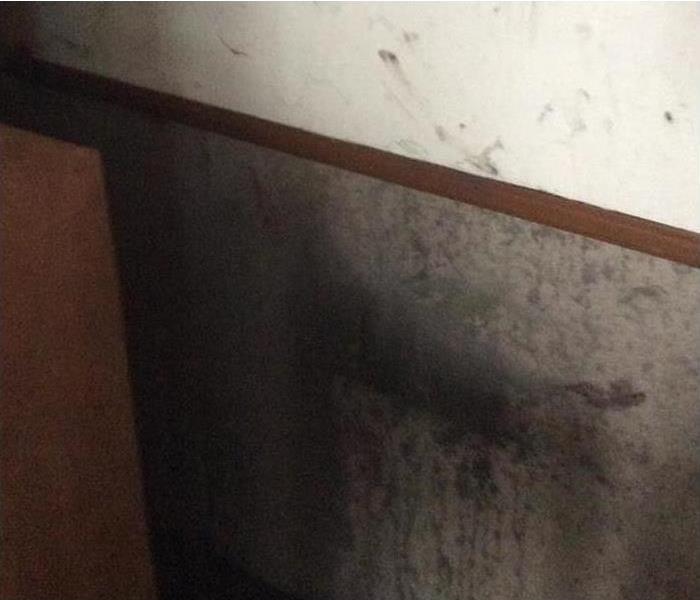Recent Mold Remediation Posts
Mold Containment: What You Should Know
3/6/2019 (Permalink)
 Air Systems Must Be Turned Off
Air Systems Must Be Turned Off
3 Things You Should Know About Mold Containment
Have you been dealing with mold contamination at your Liberty, MO, home? If so, you probably have many questions regarding the mold remediation process. Your local restoration technicians can take many steps to restore your property. One of the most important of these is mold containment. Here are three things you should know about this vital process.
1. Containment Stops the Spread of Mold
Why is containment so important? As it turns out, mold spores can spread fairly quickly when they are present. This means that surfaces in your home that are currently unaffected by mold could be damaged without swift action - which is why cleanup professionals quickly take thorough containment steps as part of their mold contamination processes.
2. Air Systems Must Be Turned Off
This is one of the most important steps to take when attempting to prevent mold migration. Air conditioners, heating systems and even fans must be shut down when mold is present, as spores can travel through air and damage other sections of your home that may not be anywhere near the source of mold. If you can, turn off all of your HVAC devices and fans before cleanup crews arrive to quickly reduce the likelihood of extensive mold damage.
3. Different Cleanup Methods Can Be Used
There are a few methods that cleanup professionals may use for mold containment. These can include the use of negative air pressure to halt the spread of mold and negative air chambers to physically isolate any growth. Keep in mind that these are advanced procedures, and your particular situation may warrant other solutions.
If you have any questions about mold contamination or cleanup during the restoration process, do not hesitate to ask your on-site residential remediation professionals. They should have experience dealing with such matters and know how to respond to even some of your most difficult mold-related concerns.
What You Should Know About Mold in Your Home
1/23/2019 (Permalink)
 Mold in your Liberty, MO home
Mold in your Liberty, MO home
Unfortunately, mold growth is a common issue homeowners in Liberty, MO frequently encounter. Various types of mold, including black mold, can result in a costly cleanup. However, it can be helpful for homeowners to learn about mold growth, so the issue can be prevented if possible.
What Causes Mold to Grow?
In your home, there are various reasons mold may grow. However, the following issues make mold growth much more likely to occur.
- A moisture problem in the home due to high levels of humidity or other factors
- Locations in the home that are not dry for long periods of time
- Access to organic materials, which can include a variety of common surfaces in the home
Why Does Mold Reappear?
There are some areas in your home that are more likely to experience mold growth than others. However, when mold keeps appearing in one area after it has been removed, this could be a sign of a problem. If an area does not remain dry and is consistently damp, this can allow mold to grow again in the same area. If mold is not properly removed in a timely manner, black mold may begin to grow in the area.
Can Mold Be Prevented?
Every situation is different, but there are several ways to prevent mold from growing in your home. Since mold thrives in damp environments, keeping your home dry is often important. In areas that experience high levels of humidity, such as bathrooms or kitchens, it can be helpful to make sure there is no standing water after appliances have been used. If you do notice standing water, quickly cleaning it can stop mold growth.
Learning more about mold can help you prevent black mold and other types of mold from causing damage to your home. If your home has been affected by mold and you need assistance with the mold cleanup process, consider contacting mold remediation professionals.
How To Keep Mold and Mildew Out of Your Bathroom
9/14/2018 (Permalink)
 Know where to look for Mold and Mildew and how to spot it!
Know where to look for Mold and Mildew and how to spot it!
Your bathroom’s sinks, toilet, tub and shower are frequently exposed to water. Because mold and mildew thrive in moist environments, this room can be a potential breeding ground for both organisms.
To reduce your risk of bathroom mildew and mold, follow these tips.
Increase Air Circulation
Taking a hot shower can create a high humidity problem inside the room. Using bathroom fans during and after your shower can reduce the humidity level as well as condensation buildup on mirrors and other surfaces.
Dry Your Shower
You should wipe and dry your shower’s surface after use to eliminate pooled water and excessive moisture.
Routinely Clean the Shower
You can also reduce bathroom mildew by routinely cleaning your shower and tub. This includes wiping down walls and bathmats with a cleaning solution. If possible, install a washable shower curtain that you can routinely clean with your washing machine.
Avoid Piles of Wet Clothing
Cloth is porous and offers many hiding places for mold spores. To avoid mold and mildew growth, you should hang towels up to air dry after use and avoid piling wet clothing, towels and washcloths in one location.
Use Mold-Resistant Caulking
It’s not uncommon for water to pool in the area surrounding sinks, tubs and showers. You can waterproof these spots using a mold-resistant caulking. You should also routinely inspect caulking for signs of deterioration, such as cracking, and replace as necessary.
Address Drafty Windows
Your bathroom’s window sills are also potentially susceptible to mold and mildew growth because cold drafts around the window can produce condensation. To eliminate drafts, apply plastic film or weather stripping around the window.
A Manageable Issue
Proactively managing moisture is key to preventing bathroom mildew and mold in any Kansas City, Kansas home. In the event of a burst pipe or overflowing toilet, a quick and efficient cleanup is imperative. If your bathroom sustains significant water damage, a professional cleanup and restoration crew can provide timely assistance and help ensure mold does not find hiding spots inside your saturated bathroom.
Mold: A Primer
7/11/2018 (Permalink)
"Black mold" is a term frequently tossed around water-cooler conversations these days. People mention it often and talk about how they should get rid of it. The fact is that all molds, not just black mold, are not welcome indoors. Here is a primer on mold so you can improve the quality of the breakroom chatter with facts.
Mold Is a Fungus.
Molds are so common that most people can identify them by their fuzzy appearances, due to tiny little filaments called hyphae. The thousands of species of molds are fungi, and they need oxygen, moisture, and organic materials to survive, which means they can survive nearly everywhere. While they are surviving, they are digesting and destroying your building materials. Some molds, including black mold, give off mycotoxins. These are odorous gases resulting from the digestive process. You are also probably familiar with the dusty surface on molds, which are actually mold spores. They travel around the air and settle in areas, where if moist enough, they will take root and develop into colonies.
Mold Infestations Can Be Prevented.
You can never fully get rid of mold in your building in Kansas City, MO because more spores will just come in through the doors or ventilation systems. Sometimes spores even travel inside by taking a ride on your clothing. Mold exists naturally in the environment, and if there is moisture then there is mold. Even though mold spores are everywhere, you can still take some simple steps to control mold and prevent infestations.
• Clean your building regularly, especially carpets and HVAC systems to prevent spore buildup.
• Reduce high humidity, which is a moisture problem, with good ventilation and proper use of air conditioning.
• Fix leaks and repair water-damaged building materials as soon as possible.
Once you find mold, you need to act fast to prevent damage and the spread of more colonies. The source of the water damage should be fixed immediately. Mold remediation professionals can help with mold cleanup, creating a containment area and special air scrubbers to prevent further spread of mold.
For more information, please visit us at http://www.SERVPROclaycounty.com/.
4 Tips to Help You Stop Mold From Growing in Your Bathroom
5/15/2018 (Permalink)
Bathrooms are the perfect place for mold growth to start. The damp environment invites spores to make a home in your Kansas City, MO, house. Because this room is notorious for having extra moisture, it can be hard to stop mold from appearing time after time. A residential mold cleanup crew may be able to help you stop this cycle. These experts can help you address water damage, cleanup mold and prevent new growth. Consider these tips as you try to put an end to bathroom mold.
1. Use Ventilation. Steam can create a great environment for fungus just as well as water damage can. If you want to make sure excess moisture doesn't build up in your bathroom, you need to find a way to help it escape. Fans and ventilation systems are a great tool to use in this space. Be sure to have the fan on when you use the tub or shower.
2. Dry the Shower. After you're done in the shower, water tends to cling to walls, floors and curtains. This clinging water can encourage mold growth. If you are able to, you should get the water out of your tub or shower to reduce the moisture buildup. You can use towels or a special shower squeegee to dry off your shower.
3. Reseal Fixtures. Faucets can become uncaulked after years of use. When this happens, you may notice leaking water. Water can also get trapped in these small crevices. You can reseal the fixtures in your bathroom every year to ensure they don't provide a place for mold to grow.
4. Repair Grout Lines. Cracked grout lines can also trap water and encourage mold growth. Most grout has a waterproof sealer, but this can wear out over the course of time. You should repair and reseal grout lines to keep your bathroom in top shape.
Your bathroom is susceptible to water damage and fungus growth. You can follow these tips to kick your mold prevention into top gear.
For more information, please visit us at http://www.SERVPROclaycounty.com/.
What Causes Discoloration of Ceiling Tiles?
4/20/2018 (Permalink)
 Discoloration and mold on Ceiling Tile, likely the result of a water damage.
Discoloration and mold on Ceiling Tile, likely the result of a water damage.
Dropped tile ceilings are an inexpensive and popular feature of many commercial buildings in Gladstone, MO.
For the most part, they remain just outside of our notice, silently creating a barrier between occupied spaces and the rafters above. But every once in a while, a particular tile or group of tiles starts to look a little bit different from the others. There are a number of reasons for tile discoloration, ranging from aging to tile mold.
Determining the Cause: Common Culprits
- Age. Dropped tile ceilings became popular in the 1950s. Older tiles look different from newer tiles, in part because of changes in the materials and processes used to manufacture the tiles. Older tiles may also have been exposed to cigarette smoke or other pollutants, which can make them appear darker in color. Check building records to see how old your ceiling tiles are, and whether there are tiles of different ages in different areas.
- Lighting. Ultraviolet light can cause tile discoloration. Hospitals and labs frequently use UV light to sterilize equipment, and UV rays are commonly used to cure inks, coatings and adhesives. Ceiling tiles that are exposed to these types of light can take on a different hue over time. Check for sources of UV light in your building.
- Water damage. When ceiling tiles are exposed to water because of problems in the plumbing, HVAC system or roof, they take on a brownish color. If the source of the water is not repaired, tile mold can take hold, making the tiles even darker in appearance.
Replacement is Quick, Easy and Important
Fortunately, most ceiling tiles are easy to replace, and bringing your ceiling back to its original uniformity is a quick and inexpensive process. If the discoloration is caused by tile mold, be sure to replace the tiles as soon as possible, as mold can spread quickly to other porous surfaces.



 24/7 Emergency Service
24/7 Emergency Service




